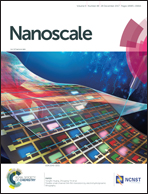A new strategy to address the challenges of nanoparticles in practical water treatment: mesoporous nanocomposite beads via flash freezing†
Abstract
Various engineering nanoparticles (NPs) exhibit high reactivity and great potential for water decontamination. Encapsulation of NPs into millimeter-sized polymer hosts is a very promising strategy to address their inherent bottlenecks for scale-up water treatment such as aggregation, difficult operation and potential risks when released into water. However, the inevitable host pore blockage accompanying NP loadings significantly compromise their decontamination reactivity. Herein, a newly developed flash freezing method was utilized to embed α-Fe2O3 NPs (3 nm, 7 nm and 18 × 90 nm) inside millimetric polystyrene to prepare mesoporous nanocomposites Fe2O3@PS. All the as-obtained Fe2O3@PS nanocomposites feature high mesoporosity, well-dispersed NPs and highly accessible sites. The amount of Fe–OH species, i.e., the active sites for As(V) sequestration, of the embedded 3 nm-Fe2O3 is dramatically increased 3.6 times over the bare NPs, resulting in higher adsorption capacity and affinity. The 3 nm-Fe2O3@PS is capable of producing clean water 2000-fold greater in mass successively in column adsorption, with As(V) reducing from 176 μg L−1 initially to <1 μg L−1. Also, Fe2O3@PS can be readily regenerated for cyclic use with negligible NPs leaking into water. This study provides an elaborate strategy to address the trade-off between easy operation and decontamination reactivity of NPs for water treatment.



 Please wait while we load your content...
Please wait while we load your content...